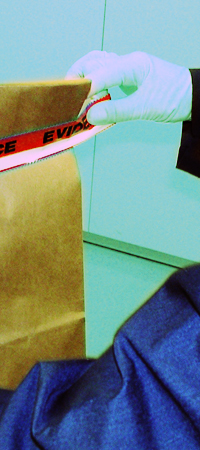Home | Glossary | Resources | Help | Contact Us | Course Map
Archival Notice
This is an archive page that is no longer being updated. It may contain outdated information and links may no longer function as originally intended.
Proper Evidence Collection and Packaging
As first responders and crime scene technicians assess the scene and collect evidence, it is important they use proper packaging. Most biological evidence is packaged in paper bags or boxes. Unless it is thoroughly air-dried, biological evidence should not be packaged in plastic because it promotes the growth of mold and degrades the biological evidence, rendering it useless for DNA testing. Items should be air dried and packaged individually, as packaging wet or damp items may cause unintended transfer of biological material onto the packaging.7,8
7 Example of Missouri Highway Patrol Crime Laboratory Packaging: Information in Department Newsletter: Under the Scope, Vol.1, Iss.3 (2001) PDF download: 124kB • Also available on their website »
8 Oklahoma State Bureau of Investigation - Criminalistics Services Division (OSBI CSD) Evidence Packaging and Sealing Guidelines PDF download: 56kB • Visit the Oklahoma State Bureau of Investigation »
Additional Online Courses
- What Every First Responding Officer Should Know About DNA Evidence
- Collecting DNA Evidence at Property Crime Scenes
- DNA – A Prosecutor’s Practice Notebook
- Crime Scene and DNA Basics
- Laboratory Safety Programs
- DNA Amplification
- Population Genetics and Statistics
- Non-STR DNA Markers: SNPs, Y-STRs, LCN and mtDNA
- Firearms Examiner Training
- Forensic DNA Education for Law Enforcement Decisionmakers
- What Every Investigator and Evidence Technician Should Know About DNA Evidence
- Principles of Forensic DNA for Officers of the Court
- Law 101: Legal Guide for the Forensic Expert
- Laboratory Orientation and Testing of Body Fluids and Tissues
- DNA Extraction and Quantitation
- STR Data Analysis and Interpretation
- Communication Skills, Report Writing, and Courtroom Testimony
- Español for Law Enforcement
- Amplified DNA Product Separation for Forensic Analysts


